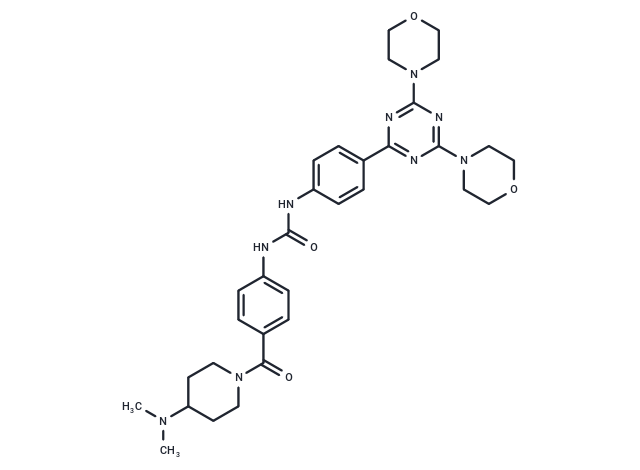Shopping Cart
Remove All Your shopping cart is currently empty
Your shopping cart is currently empty
Gedatolisib (PF-05212384) is a highly effective dual inhibitor targeting the PI3Kα/γ (IC50: 0.4/5.4 nM)and mTOR (IC50: 1.6 nM) in the PI3K/mTOR signaling pathway.

| Pack Size | Price | USA Warehouse | Global Warehouse | Quantity |
|---|---|---|---|---|
| 2 mg | $45 | In Stock | In Stock | |
| 5 mg | $72 | In Stock | In Stock | |
| 10 mg | $122 | In Stock | In Stock | |
| 25 mg | $238 | In Stock | In Stock | |
| 50 mg | $447 | In Stock | In Stock | |
| 100 mg | $663 | In Stock | In Stock | |
| 500 mg | $1,390 | In Stock | - |
| Description | Gedatolisib (PF-05212384) is a highly effective dual inhibitor targeting the PI3Kα/γ (IC50: 0.4/5.4 nM)and mTOR (IC50: 1.6 nM) in the PI3K/mTOR signaling pathway. |
| Targets&IC50 | PI3Kα (H1047R):0.6 nM, PI3Kα (E542K):0.6 nM, mTOR:1.6 nM, PI3Kγ:5.4 nM, PI3Kβ:6 nM, PI3Kδ:6 nM, PI3Kα:0.4 nM |
| In vitro | In a xenograft model of H1975 non-small cell lung cancer (NSCLC) with EGFR mutations (L858R, T790M), treatment with PKI-587 at a dose of 25 mg/kg for seven days resulted in a 90% survival rate in the experimental group. PKI-587 administration (25 mg/kg, intravenously) in nude mice showed a high volume of distribution (7.2 L/kg), low plasma clearance rate (7 mL/min/kg), and an extended half-life (14.4 hours). In the MDA-361 xenograft tumor model, PKI-587 demonstrated significant antitumor activity, with the lowest effective dose being 3 mg/kg and the maximum tolerated dose at 30 mg/kg. |
| In vivo | In both the MDA-361 and PC3-MM2 cell lines, PKI-587 exhibits inhibitory effects on tumor cell growth, with IC50 values of 4 and 13.1 nM, respectively. Additionally, PKI-587 is effective against mutations in PI3Kα, particularly the H1047R and E545K mutations, displaying IC50 values of 0.6 nM for both. |
| Kinase Assay | PI3K and mTOR kinase assay : Enzyme assays are done in fluorescent polarization (FP) format, adapted from the Echelon K-1100 PI3K FP assay kit protocol. Human class I PI3Ks and PI3K-α mutants (E545K and H1047R) are produced in Sf9 or purchased from Upstate Biotech. GST-GRP1 (murine) is produced in Escherichia coli and isolated by GST-Sepharose. Assay buffers are reaction buffer [20 mM HEPES (pH 7.1), 2 mM MgCl2, 0.05% CHAPS, and 0.01% β-mercaptoethanol] and stop/detection buffer [100 mM HEPES (pH 7.5), 4 mM EDTA, 0.05% CHAPS]. FP reaction is run for 30 minutes at room temperature in 20 μL of reaction buffer containing 20 μM phosphatidylinositol 4,5-bisphosphate (PIP2), 25 μM ATP, and <4% DMSO. FP reaction is stopped with 20 μL of stop/detection buffer (10 nM probe and 40 nM GST-GRP), and after 2 hours, data are collected using an Envision plate reader. The routine assays with purified FLAG-TOR (FL and 3.5) are performed in 96-well plates as follows. Enzymes are first diluted in kinase assay buffer (10 mM Hepes (pH 7.4), 50 mM NaCl, 50 mM β-glycerophosphate, 10 mM MnCl2, 0.5 mM DTT, 0.25 μM microcystin LR, and 100 μg/mL BSA). To each well, 12 μL of the diluted enzyme is mixed briefly with 0.5 μL test inhibitor or control vehicle dimethyl sulfoxide (DMSO). The kinase reaction is initiated by adding 12.5 μL kinase assay buffer containing ATP and His6-S6K to give a final reaction volume of 25 μL containing 800 ng/mL FLAG-TOR, 100 μM ATP, and 1.25 μM His6-S6K. The reaction plate is incubated for 2 hours (linear at 1–6 hours) at room temperature with gentle shaking and then terminated by adding 25 μL Stop buffer (20 mM Hepes (pH 7.4), 20 mM EDTA, and 20 mM EGTA). |
| Cell Research | Cells are plated in 96-well culture plates at about 3000 cells per well. One day following plating, PKI-587 is added to cells. Three days after PKI-587 treatment, viable cell densities are determined by measuring metabolic conversion (by viable cells) of the dye MTS, a previously established cell proliferation assay. For each assay, MTS and PMS stocks are freshly thawed and mixed (MTS/PMS, 20:1). The MTS/PMS mixture is then added to 96-well cell plates at 20 μL/well, and plates are incubated for 1 hour–2 hours in cell culture incubator. MTS assay results are read in a 96-well format plate reader by measuring absorbance at 490 nm. The effect of each PKI-587 treatment is calculated as a percentage of control cell growth obtained from vehicle-treated cells grown in the same culture plate.(Only for Reference) |
| Synonyms | PKI-587, PF-05212384 |
| Molecular Weight | 615.73 |
| Formula | C32H41N9O4 |
| Cas No. | 1197160-78-3 |
| Smiles | N(C(NC1=CC=C(C(=O)N2CCC(N(C)C)CC2)C=C1)=O)C3=CC=C(C=4N=C(N=C(N4)N5CCOCC5)N6CCOCC6)C=C3 |
| Relative Density. | 1.364 g/cm3 |
| Storage | Powder: -20°C for 3 years | In solvent: -80°C for 1 year | Shipping with blue ice/Shipping at ambient temperature. | ||||||||||||||||||||
| Solubility Information | DMSO: 10 mg/mL (16.24 mM), Sonication is recommended. | ||||||||||||||||||||
Solution Preparation Table | |||||||||||||||||||||
DMSO
| |||||||||||||||||||||
| Size | Quantity | Unit Price | Amount | Operation |
|---|

Copyright © 2015-2025 TargetMol Chemicals Inc. All Rights Reserved.